Henry Gurney's Final Fight
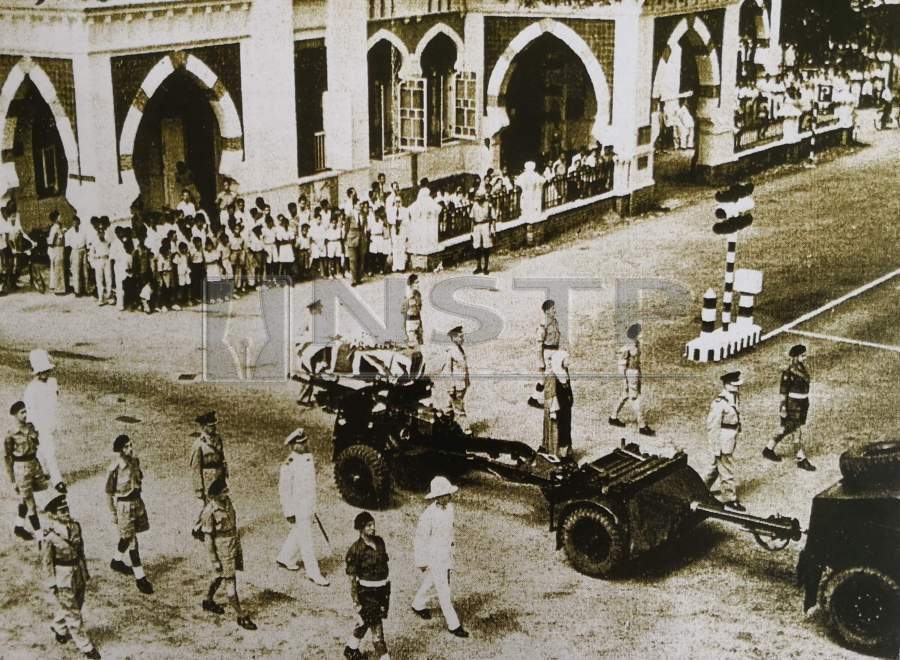
Gurney's funeral procession through the streets of Kuala Lumpur on Oct 8, 1951.
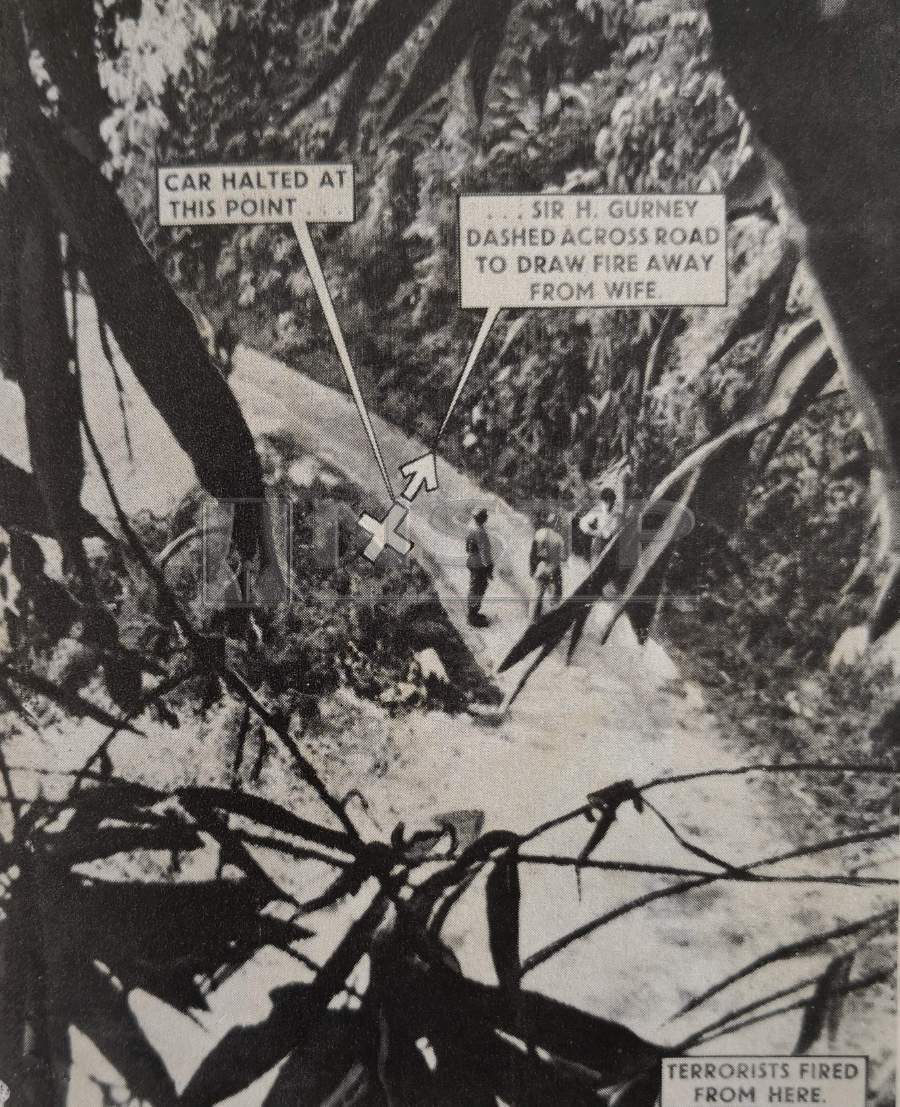
 Gurney's funeral procession through the streets of Kuala Lumpur on Oct 8, 1951.
Gurney's funeral procession through the streets of Kuala Lumpur on Oct 8, 1951.




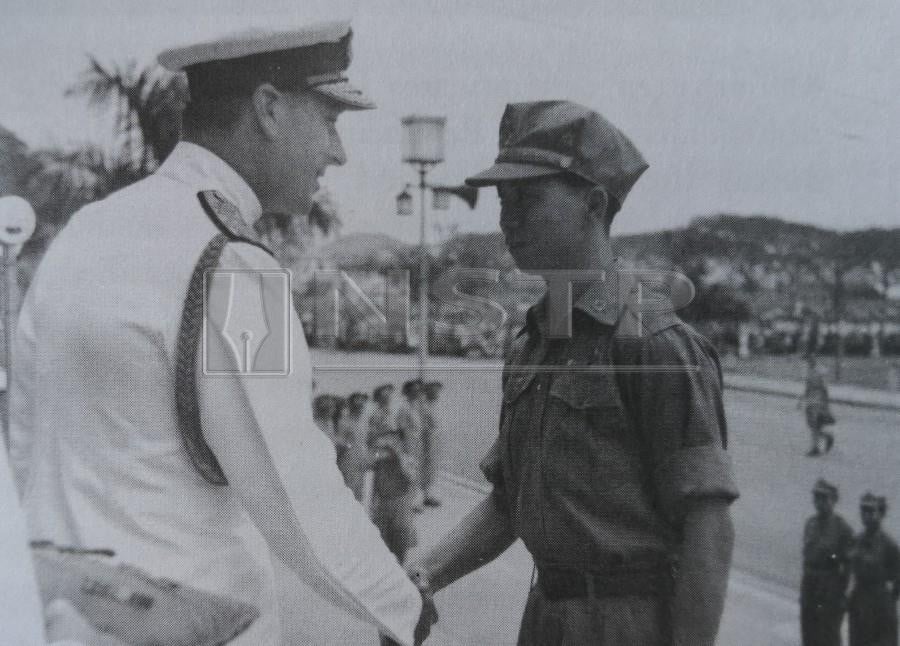
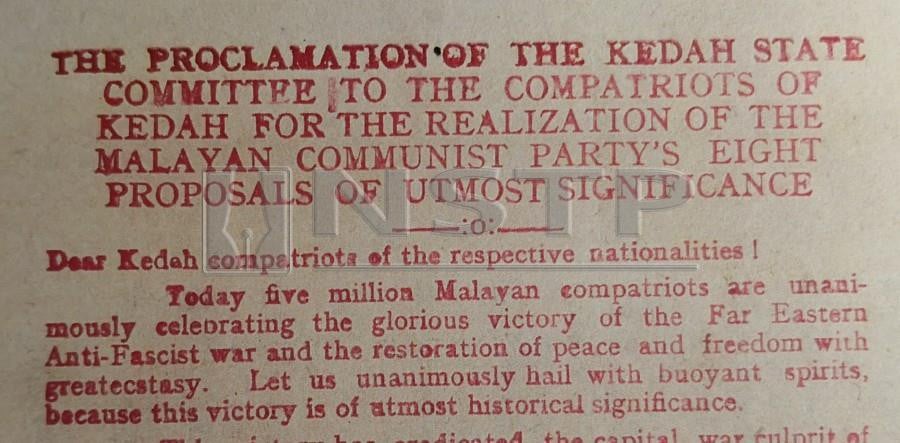
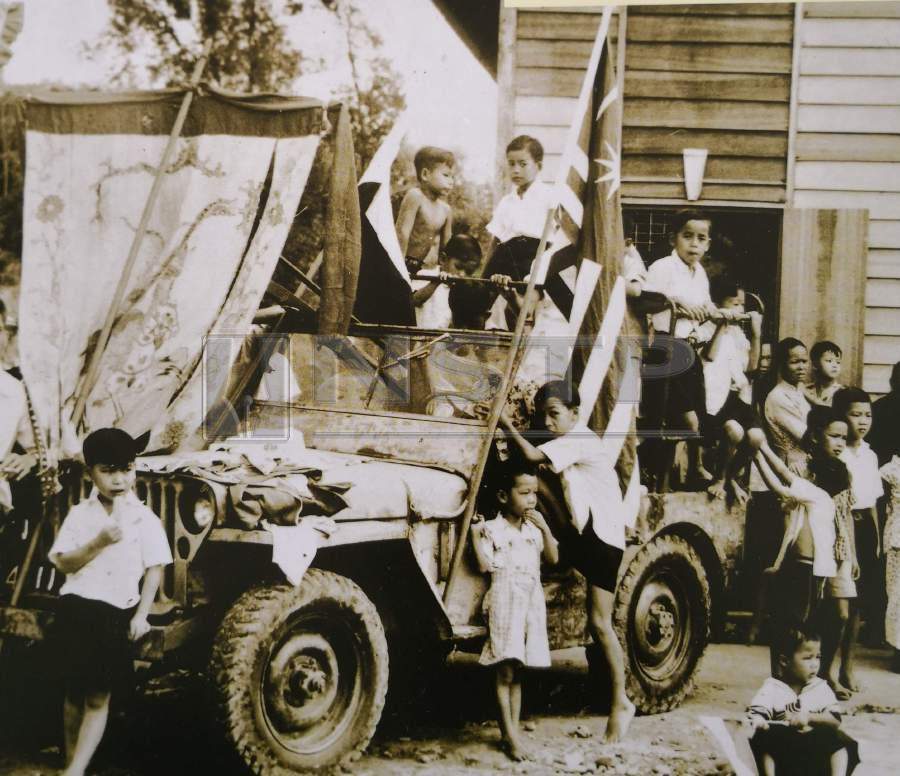

PERJUANGAN TERAKHIR HENRY GURNEY
 Perarakan pengebumian Gurney melalui jalan raya di Kuala Lumpur pada 8 Okt 1951
Perarakan pengebumian Gurney melalui jalan raya di Kuala Lumpur pada 8 Okt 1951
Persekitaran dipenuhi dengan nyamuk dan seekor nyamuk menghinggap di atas lengan kanan berpeluh Siew Mah. Namun, beliau dari Regimen ke-11 Pahang dan orang kepercayaan Chin Peng kekal berada di kedudukannya untuk serangan hendap.


Gurney moved about 600,000 Chinese squatters to new villages to deprive Chin Peng of food and information supplies.
Gurney membuat satu rancangan untuk memindah dan menempatkan semula 600,000 penduduk setinggan kaum Cina yang tinggal berhampiran hutan ke perkampungan baharu yang dipagari besi serta dikawal rapi sepanjang masa.
 The villagers at Tras were accused of harbouring Gurney's murderers and the entire village had to move out to Ipoh and was only allowed to return in 1958.
The villagers at Tras were accused of harbouring Gurney's murderers and the entire village had to move out to Ipoh and was only allowed to return in 1958.
Penghijrahan ini meningkat secara mendadak pada era Pendudukan Jepun. Keadaan menjadi amat sukar dan ramai orang Cina yang kebuluran meninggalkan bandar dan menetap dengan keluarga mereka di atas tanah yang merupakan hutan belantara yang dibersihkan.


Chin Peng menerima Bintang Burma dan Bintang 1939/45 daripada Mountbatten pada 6 Jan 1946.

Part of the leaflet issued by the communist terrorists to persuade Alor Star residents to support their actions after the Japanese surrendered.

Sir Gerald Templer took over Gurney's post as High Commissioner of Malaya and managed to bring the Emergency to an end 12 years after it started in 1948.
Diterjemah oleh : Teratai Melur
E-Mel : terataigenius@gmail.com

Gurney's funeral procession through the streets of Kuala Lumpur on Oct 8, 1951.
The place is infested with mosquitoes and one glides to a halt on Siew Mah's sweat-soaked right forearm. Yet, the guerrilla commander of Pahang's 11th Regiment and close confidante of Chin Peng remains motionless at his ambush station.
His eyes and mind are transfixed on the section of narrow twisting road further in front that forms an almost perfect S-shaped bend.
Siew Mah moves his head slowly to check on the positions of the rest of his 38-member platoon.
The movement startles the mosquito and it quickly flies away without having the chance to draw blood. From the corner of his eyes, the commander traces the tracks connected to his three Bren-gun firing positions.
Satisfied, he turns to check the crucial withdrawal route where he and his men will dissolve back into the jungle once the act had been committed.
The date is Oct 6, 1951 and the communist terrorists have been frozen in their respective posts for two whole days, waiting patiently to ambush a military convoy which they’d been told would pass that way.
Siew Mah badly needed to get his hands on arms to shore up his fast depleting weapons cache.
Unfortunately for the bandits, the information is flawed as the promised fleet of military vehicles didn’t turn up. Only private vehicles are seen passing regularly up and down the hill, which was just a few kilometres north of Tras. Further up lies the popular hill resort of Fraser's Hill.
By noon, Siew Mah gives the signal to withdraw but his men are unwilling to throw in the towel. Their suggestion to attack the next official car flying pennants is accepted by their leader. Siew Mah realises that after all the trouble his men had gone through in preparation for the intended ambush, he had to give them a win to boost their otherwise sagging morale.
UNINTENDED TARGET
Nearly an hour later, a three-vehicle motorcade swings around the corner. Leading the pack is a Land-Rover carrying six policemen.
Directly behind is a black chauffeur-driven Rolls-Royce flying the Union Jack. The third vehicle is out of view from Siew Mah's vantage position. A later post-mortem of the incident revealed that its engine had stalled.
Without a moment's hesitation, Siew Mah gives the signal for his men to unleash furious bursts of machinegun fire. The aggressors didn’t have the faintest idea that inside the Rolls Royce is Sir Henry Gurney, the High Commissioner of Malaya, his wife and secretary, JD Staples, on their way to Fraser's Hill for the weekend.
With the chauffeur hit almost instantaneously by a hail of bullets, the car slowly grinds to a halt at a grassy patch by the side of the road with its badly shot-up tyres in shreds. Unaware that his motorcade had been just a blind target, Gurney looks at his wife and aide crouching on the car floor. He knows that he has to act fast to save their lives.
Without a second to waste, Gurney wrenches open the door, steps out into the open and bangs it shut.

Section of the Kuala Kubu Bharu road where Gurney was assassinated.

Then he starts walking towards the roadside. The waiting bandits must have been taken aback by this unexpected move. They pause for a moment before releasing a hail of gun fire moments later to send Gurney crumpling on the grass verge. The British High Commissioner to Malaya is dead.
Although the incident happened exactly 67 years ago, it’s easy to put to mind the events that took place on that fateful Saturday afternoon based on the Straits Times report I accidentally stumbled upon while searching for a misplaced book among the piles of reading material in my study.

Gurney's Rolls Royce was riddled with 35 bullet holes.
Despite not being in very good condition, I’m still able to put together the badly fraying newspaper pieces and read Harry Miller's detailed account written soon after he visited the scene of the assassination and spoke to survivors, including Gurney's widow and Staples. It was nothing short of a miracle that the duo managed to escape unscathed as 35 bullet holes were counted on their Rolls Royce.
BLACKEST DAY
The general public was numbed by shock when Miller's story was published the next day. Considered the blackest day in the history of the Malayan Emergency, Gurney's death began raising questions in the mind of the people. Many began to wonder if the authorities were ever going to triumph over the communists who seemed to be growing from strength to strength since their reign of terror began three years ago.
The audacity of the terrorists in assassinating the heavily-escorted British High Commissioner, one considered in the hierarchy of British Imperial rule to be as inviolable as the Queen, in broad daylight clearly showed that the authorities had underestimated the strength of the insurrection.
Two days after the incident, as thousands of people from all walks of life lined the streets of Kuala Lumpur to witness Gurney's cortege on a gun carriage make its way towards the Cheras War Cemetery in Kuala Lumpur, many a tear was shed for the man who was the chief architect of British policy since the first day he arrived in Malaya on Oct 1, 1948.

Gurney (left) arrived in Malaya to assume the post of High Commissioner on Oct 1, 1948.
Succeeding Sir Edward Gent, Gurney had been Chief Secretary in Palestine during the last two years of the British mandate.
Described as a slight man of 50, with receding hairline and grey moustache, Gurney's self-confidence was almost legendary during the last few frightful months in the Middle East. He even insisted on his daily round of golf up until the day when he theatrically wound up the administration by taking the last plane out of Palestine.
POLITICAL WAR
Upon his arrival in Kuala Lumpur, Gurney was quick to grasp the situation and realised the fundamental truth that the communist uprising was a political war where arms alone could never subdue. To him, the major key to victory was political stability.
The Malayan government had to function and, more importantly, the people must see the administration run 'business as usual' style or else there’d be no hope for the millions caught up in the turmoil. Gurney strongly believed that without hope and belief in the government, the only alternative for the people would be communism.

Souvenir programme for the London Victory Celebrations held on June 8, 1946.
With the support of like-minded Malayan administrators like Malcolm MacDonald, Gurney successfully persuaded London not to lean towards an all-out war.
He warned that an unending pattern of escalation and the inevitable toll on innocent civilians would result in hatred for the government and tilt the balance in favour of bandit leader, Chin Peng.
Instead of direct confrontation, Gurney gave the world its first glimpse of how communist terror tactics could be effectively eroded by launching a plan which marked an unprecedented social revolution never before seen in the history of British overseas rule.
UNPRECEDENTED RESETTLEMENT

Gurney moved about 600,000 Chinese squatters to new villages to deprive Chin Peng of food and information supplies.
Gurney set in place a plan to uproot and resettle around 600,000 Chinese squatters living on land near the jungle fringe and put them in barbed wired new villages with round the clock security.
Through this herculean nationwide removal operation, Gurney hoped to deprive Chin Peng of hundreds of thousands of both willing and unwilling supporters.
Squatters are known to have already existed ever since the time when the Chinese began immigrating to Malaya in huge numbers in the late 19th century.
But their numbers began to increase at a phenomenal rate during the Japanese Occupation. During those times of great hardship, many starving Chinese abandoned the city and settled with their families on land acquired by simply clearing the jungle.
Chin Peng already realised the value of these squatters when he was heading the Malayan Peoples' Anti-Japanese Army (MPAJA), a guerrilla force that opposed the Japanese army during Second World War.
A staunch British ally at that time, Chin Peng and his men received huge supplies of weapons, cash and tactical knowledge to wreak havoc on the Japanese troops.
Malaya was thrown into chaos once the Japanese surrendered on Aug 15, 1945 as the bulk of the British troops had yet to return to assume control. Attempting to fill the power vacuum, the MPAJA emerged from the jungle and began their reign of terror by killing and torturing those suspected of abetting the Japanese during the war.
Looking at several MPAJA issued leaflets in my collection, it’s evident that the guerrillas were intent upon seizing control of most major towns in the country and set up their own communist administration.
Fortunately, the timely return of the British during the first week of September 1945 called time on their brief period of influence and the MPAJA was subsequently disbanded.
FRIENDS TURN INTO MORTAL ENEMIES
During Victory Day celebrations held throughout Malaya, the guerrillas publicly laid down their arms in return for monetary rewards. The British also bestowed honours upon many of them during these events in recognition of their gallantry during the Japanese Occupation.

Chin Peng receiving the Burma Star and the 1939/45 Star from Mountbatten on Jan 6, 1946.
Chin Peng received three prestigious medals for his wartime effort. On Jan 6, 1946 he was decorated twice by the Supreme Allied Commander, Admiral Lord Mountbatten at the steps of Singapore's City Hall and six months later was given the Order of the British Empire medal at the London Victory Celebrations on June 8, 1946.
Unfortunately, a string of related events that happened after that caused Chin Peng and his men to return to the jungle in 1948 and continue their struggle to establish a communist government in Malaya.

Part of the leaflet issued by the communist terrorists to persuade Alor Star residents to support their actions after the Japanese surrendered.
In the jungle, Chin Peng depended heavily on the squatters for food and information.
He launched ferocious campaigns of intimidation after realising that quite a number of the squatters were reluctant to help. Waverers quickly toed the line when their family members were hacked to death in front of their very eyes. "Cooperate or we’ll kill another one" soon became the guerrillas' trademark parting shot before slipping back into the jungle.
These atrocities were among the many reasons that helped Gurney persuade the squatters to move to the safety of the new villages. First, however, Gurney had to overcome the stumbling block of land acquisition before his plan could become a reality.
Gurney formed a Squatters' Committee and started work on what was to become known as the Briggs Plan. Using patience, tact and understanding he successfully persuaded the Malay rulers that it was to their advantage to give away land titles for him to build new villages.
TIGHTENING THE NOOSE

The villagers at Tras were accused of harbouring Gurney's murderers and the entire village had to move out to Ipoh and was only allowed to return in 1958.
Little by little, Gurney tightened the noose around his enemy. He gave the police far-reaching powers to detain suspects for up to two years without trial, impose curfews, conduct house searches without warrant and impose strict control on food and traffic movements. Death sentences were mandatory for those convicted of illegally carrying arms.
These measures, coupled with the death of several senior communist leaders in the early days of the Emergency, caused a great upheaval among Chin Peng's men. Unknown to the British at that time, a Central Executive document telling of disenchantment in the ranks was circulating among the guerrillas.
The Malayan government could have routed the communist terrorists by the end of 1949 if only it had realised how close they were to total defeat. Instead, the Malayan government took an unexplainable breather in its war against terror.
That fatal mistake on Gurney's part added many more years to the costly Emergency. It also gave Chin Peng the golden opportunity to re-group and prepare for his next massive offensive, the very one that played a part in Gurney's untimely death.
Returning the newspaper and leaflets carefully back into their protective plastic sleeves, I recall the enduring legacy left behind by Gurney.

Sir Gerald Templer took over Gurney's post as High Commissioner of Malaya and managed to bring the Emergency to an end 12 years after it started in 1948.
Today, many roads and prominent places in Malaysia and Singapore still bear his name. Visiting Perak's Pekan Gurney and Penang's popular beachfront Gurney Drive will prompt us to think of the brave man who unselfishly laid down his life for his friends.
Written by : Alan Teh Leam Seng
Date : Oct 7, 2018
Link : https://www.nst.com.my/lifestyle/sunday-vibes/2018/10/418756/henry-gurneys-final-fight
Date : Oct 7, 2018
PERJUANGAN TERAKHIR HENRY GURNEY
Ulang tahun pembunuhan Sir Henry Gurney ke-67 mendorong penulis mengimbas kembali rentetan peristiwa yang berlaku pada awal Zaman Darurat.

Persekitaran dipenuhi dengan nyamuk dan seekor nyamuk menghinggap di atas lengan kanan berpeluh Siew Mah. Namun, beliau dari Regimen ke-11 Pahang dan orang kepercayaan Chin Peng kekal berada di kedudukannya untuk serangan hendap.
Mata dan fikirannya tertumpu pada bahagian belok sempit jalan raya di hadapan yang seolah-oleh bentuk S sempurna.
Secara perlahan-lahan Siew Mah menoleh untuk melihat kedudukan ahli pasukannya seramai 38 orang.
Pergerakan ini mengejutkan nyamuk lalu ia terbang dengan pantas tanpa berpeluang untuk menghisap darah. Dari tepi matanya, komander itu menjejaki langkah menuju ke arah tiga kedudukan penembak.
Berasa puas hati, dia mengalihkan pandangannya untuk melihat jalan keluar penting bagi dia dan pasukannya untuk memasuki semula hutan setelah selesai menjalankan tugas.
Hari itu bertarikh 6 Okt 1951 dan pengganas-pengganas komunis telah berkubu di tempat masing-masing selama dua hari. Mereka menunggu dengan sabar untuk menyerang hendap sebuah konvoi tentera yang dikhabarkan akan melalui jalan itu.
Siew Mah perlu menambah senjata-senjata yang sedang kehabisan.
Malangnya bagi penjahat-penjahat tersebut, maklumat yang diberikan tidak tepat kerana rombongan kenderaan tentera tidak muncul-muncul. Hanya kenderaan persendirian melalui bukit yang terletak beberapa kilometer di sebalik Bukit Fraser.
Menjelang tengah hari, Siew Mah memberikan tanda agar berundur tetapi pasukannya enggan berbuat demikian. Mereka mencadangkan agar menyerang kenderaan rasmi yang mengibarkan panji-panji. Idea ini diterima oleh ketua mereka. Siew Mah menyedari akan penat lelah yang dilalui oleh anak-anak buahnya bagi serangan hendap ini. Dia harus memberikan mereka kemenangan bagi menaikkan semangat mereka.
SASARAN YANG TIDAK DISANGKA
Setelah hampir sejam menunggu, perarakan tiga buah kereta membelok di lencongan. Mengetuai rombongan tersebut adalah sebuah kereta Land-Rover yang membawa enam anggota polis.
Betul-betul di belakang Land-Rover ialah kereta Rolls-Royce mengibarkan bendera Union Jack. dipandu oleh pemandu. Kenderaan ketiga tidak dapat dilihat dari kedudukan strategik Siew Mah. Kaji selidik mengenai kejadian ini menunjukkan enjin kereta telah terhenti.
Tanpa agak-agak, Siew Mah memberikan isyarat kepada anak-anak buahnya untuk melepaskan tembakan. Para penyerang tidak menyedari penumpang kereta Rolls Royce ialah Sir Henry Gurney, Duta Besar Malaya, isterinya serta setiausahanya, JD Staples dalam perjalanan ke Bukit Fraser untuk menghabiskan masa hujung minggu.
Kereta tersebut berhenti secara perlahan di tepi jalan raya dengan pemandunya hampir dihujani peluru serta tayar kereta yang telah rosak. Gurney tidak menyedari konvoinya telah menjadi sasaran tanpa dirancang, beliau melihat isteri dan pemandunya membongkok di lantai kereta dan beliau menyedari harus bertindak pantas bagi menyelamatkan nyawa mereka.
Tanpa membuang masa, Gurney terus membuka pintu kereta, melangkah keluar dan menutup pintu kereta dengan kuat.
Lalu, beliau berjalan di tepi jalan raya. Para pengganas pasti terperanjat dengan perlakuan beliau. Mereka terhenti sejenak sebelum menghujani beliau dengan peluru membuatkan beliau jatuh tersungkur di atas tanah berumput. Duta Besar British ke Malaysa telah meninggal dunia.
Walaupun kejadian ini berlaku 67 tahun lalu namun ia mudah untuk digambarkan apakah yang berlaku pada hari Sabtu yang malang itu. Ini berdasarkan pada laporan dalam surat khabar Straits Times yang saya temukan secara tidak sengaja ketika sedang mencari sebuah buku yang hilang dalam timbunan bahan-bahan bacaan dalam bilik bacaan saya.

Gurney's Rolls Royce was riddled with 35 bullet holes.
Walaupun keratan akhbar ini sudah lusuh namun saya masih dapat membaca rencana yang ditulis secara terperinci oleh Harry Miller. Ia ditulis setelah beliau tiba di tempat kejadian dan menemu bual mangsa terselamat termasuk isteri mendiang Gurney dan Staples. Amat menakjubkan mereka berdua terselamat tanpa sebarang kecederaan kerana terdapat 35 kesan tembakan pada badan kereta Rolls Royce.
HARI MALANG

Tempat Gurney ditembakHari itu bertarikh 6 Okt 1951 dan pengganas-pengganas komunis telah berkubu di tempat masing-masing selama dua hari. Mereka menunggu dengan sabar untuk menyerang hendap sebuah konvoi tentera yang dikhabarkan akan melalui jalan itu.
Siew Mah perlu menambah senjata-senjata yang sedang kehabisan.
Malangnya bagi penjahat-penjahat tersebut, maklumat yang diberikan tidak tepat kerana rombongan kenderaan tentera tidak muncul-muncul. Hanya kenderaan persendirian melalui bukit yang terletak beberapa kilometer di sebalik Bukit Fraser.
Menjelang tengah hari, Siew Mah memberikan tanda agar berundur tetapi pasukannya enggan berbuat demikian. Mereka mencadangkan agar menyerang kenderaan rasmi yang mengibarkan panji-panji. Idea ini diterima oleh ketua mereka. Siew Mah menyedari akan penat lelah yang dilalui oleh anak-anak buahnya bagi serangan hendap ini. Dia harus memberikan mereka kemenangan bagi menaikkan semangat mereka.
SASARAN YANG TIDAK DISANGKA
Setelah hampir sejam menunggu, perarakan tiga buah kereta membelok di lencongan. Mengetuai rombongan tersebut adalah sebuah kereta Land-Rover yang membawa enam anggota polis.
Betul-betul di belakang Land-Rover ialah kereta Rolls-Royce mengibarkan bendera Union Jack. dipandu oleh pemandu. Kenderaan ketiga tidak dapat dilihat dari kedudukan strategik Siew Mah. Kaji selidik mengenai kejadian ini menunjukkan enjin kereta telah terhenti.
Tanpa agak-agak, Siew Mah memberikan isyarat kepada anak-anak buahnya untuk melepaskan tembakan. Para penyerang tidak menyedari penumpang kereta Rolls Royce ialah Sir Henry Gurney, Duta Besar Malaya, isterinya serta setiausahanya, JD Staples dalam perjalanan ke Bukit Fraser untuk menghabiskan masa hujung minggu.
Kereta tersebut berhenti secara perlahan di tepi jalan raya dengan pemandunya hampir dihujani peluru serta tayar kereta yang telah rosak. Gurney tidak menyedari konvoinya telah menjadi sasaran tanpa dirancang, beliau melihat isteri dan pemandunya membongkok di lantai kereta dan beliau menyedari harus bertindak pantas bagi menyelamatkan nyawa mereka.
Tanpa membuang masa, Gurney terus membuka pintu kereta, melangkah keluar dan menutup pintu kereta dengan kuat.
Lalu, beliau berjalan di tepi jalan raya. Para pengganas pasti terperanjat dengan perlakuan beliau. Mereka terhenti sejenak sebelum menghujani beliau dengan peluru membuatkan beliau jatuh tersungkur di atas tanah berumput. Duta Besar British ke Malaysa telah meninggal dunia.
Walaupun kejadian ini berlaku 67 tahun lalu namun ia mudah untuk digambarkan apakah yang berlaku pada hari Sabtu yang malang itu. Ini berdasarkan pada laporan dalam surat khabar Straits Times yang saya temukan secara tidak sengaja ketika sedang mencari sebuah buku yang hilang dalam timbunan bahan-bahan bacaan dalam bilik bacaan saya.

Gurney's Rolls Royce was riddled with 35 bullet holes.
Walaupun keratan akhbar ini sudah lusuh namun saya masih dapat membaca rencana yang ditulis secara terperinci oleh Harry Miller. Ia ditulis setelah beliau tiba di tempat kejadian dan menemu bual mangsa terselamat termasuk isteri mendiang Gurney dan Staples. Amat menakjubkan mereka berdua terselamat tanpa sebarang kecederaan kerana terdapat 35 kesan tembakan pada badan kereta Rolls Royce.
HARI MALANG

Pada keesokan harinya, orang awam tergamam terkejut apabila kisah yang ditulis oleh Miller disiarkan. Ia dianggap sebagai hari paling malang dalam sejarah Darurat Malaya dan kematian Gurney mula membangkitkan soalan dalam minda rakyat. Ramai mula tertanya-tanya dapatkah pihak berkuasa mengalahkan pihak komunis yang seolah-olah semakin kuat sejak mereka memulakan keganasan tiga tahun lalu.
Keberanian para pengganas membunuh Duta British ke Malaya yang dikawal rapi serta dianggap hierarki Imperial British seperti Ratu England yang tidak boleh dilanggar, secara terang-terangan menunjukkan pihak berkuasa telah salah anggap akan kekuatan pengganas.
Dua hari kemudian ribuan orang daripada pelbagai lapisan masyarakat Kuala Lumpur berbaris di tepi jalan raya untuk menyaksikan keranda Gurney di atas pendati senjata menuju ke arah Tanah Perkuburan Perang Cheras di Kuala Lumpur. Ramai yang menangis merapati Gurney yang menjadi Ketua Arkitek polis British sejak hari pertama beliau tiba di Malaya pada 1 Okt 1948.

Gurney (left) arrived in Malaya to assume the post of High Commissioner on Oct 1, 1948.
Gurney yang menggantikan Sir Edward Gent yang pernah bertugas sebagai Ketua Setiausaha di Palestin ketika dua tahun terakhir mandat British.
Beliau berusia 50 tahun, bertubuh kecil, rambut menipis dan misai berwarna putih. Lagenda keyakinan Gurney terserlah ketika beliau bertugas pada bulan-bulan terakhir di Timur Tengah. Beliau bertekad ingin bermain golf setiap hari sehingga meninggalkan Palestin dengan kapal terbang terakhir.
PERANG TERAKHIR
Setibanya beliau di Kuala Lumpur, Gurney menyedari situasi sekeliling dan keadaan sebenar akan kebangkitan komunis adalah perang politik yang tidak dapat diselesaikan dengan menggunakan senjata. Baginya, kejayaan sebenar adalah melalui kestabilan politik.
Kerajaan Malaya harus terus beroperasi, lebih penting lagi, rakyat harus melihat pentadbiran negara beroperasi seperti biasa, jika tidak, tiada harapan lagi bagi jutaan rakyat yang terlibat dalam kancah ini. Gurney percaya tanpa harapan dan kepercayaan terhadap kerajaan, rakyat akan berpaling kepada komunis.
Gurney mendapat sokongan daripada Malcolm MacDonald, pegawai pentadbir yang sependapat dengan beliau berjaya memujuk London agar tidak melancarkan serangan ke atas pihak komunis.
Beliau memberi amaran akan corak tentangan yang tidak berkesudahan serta kesan terhadap orang awam yang tidak bersalah, akan menyebabkan peningkatan kebencian terhadap kerajaan dan menyokong ketua pengganas, Chin Peng.
Gurney menunjukkan kepada dunia imbasan cara efektif yang boleh digunakan menangani taktik komunis selain menggunakan penentangan terus. Beliau melancarkan rancangan yang menjadi tanda aras menentang revolusi sosial yang tidak pernah dilihat dalam mana-mana sejarah pemerintah British.
PENEMPATAN SEMULA YANG TIDAK PERNAH BERLAKU
Gurney moved about 600,000 Chinese squatters to new villages to deprive Chin Peng of food and information supplies.
Gurney membuat satu rancangan untuk memindah dan menempatkan semula 600,000 penduduk setinggan kaum Cina yang tinggal berhampiran hutan ke perkampungan baharu yang dipagari besi serta dikawal rapi sepanjang masa.
Menerusi operasi pemindahan secara besar-besaran ini, Gurney berharap dapat menyekat Chin Peng mendapat sokongan daripada mereka yang ingin dan tidak ingin memberi bantuan.
Penempatan setinggan telah wujud sejak imigran Cina mula migrasi ke Malaya secara besar-besaran pada akhir kurun ke-19.

Penghijrahan ini meningkat secara mendadak pada era Pendudukan Jepun. Keadaan menjadi amat sukar dan ramai orang Cina yang kebuluran meninggalkan bandar dan menetap dengan keluarga mereka di atas tanah yang merupakan hutan belantara yang dibersihkan.
Chin Peng menyedari akan kepentingan penduduk setinggan ini apabila dia mengetuai Malayan Peoples' Anti-Japanese Army (MPAJA), kumpulan gerila yang menentang Jepun ketika Perang Dunia Kedua.
Pada ketika itu, dia ialah penyokong kuat British dan menerima bekalan berupa senjata, wang tunai dan berpengetahuan taktik untuk melemahkan tentera Jepun.
Malaysia telah menjadi kucar-kacir setelah Jepun menyerah diri pada 15 Ogos 1945 kerana sebahagian besar tentera British belum kembali untuk mengambil semula pemerintahan. MPAJA, mengambil kesempatan ini dengan muncul dari hutan dan mula menakutkan penduduk awam dengan membunuh dan menyeksa mereka yang disyaki bersubahat dengan Jepun ketika perang.
Sambil membelek beberapa keping risalah dalam koleksi saya, amat jelas kelihatan gerila bertekad mengambil alih kebanyakan bandar penting dalam negara dan menubuhkan pentadbiran komunis.
Nasib menyebelahi pihak British apabila mereka tiba pada minggu pertama bulan September 1945 dan berjaya mengambil alih pemerintahan dan membubarkan MPAJA.
KAWAN MENJADI MUSUH
Ketika sambutan Hari Kemenangan yang diadakan di seluruh Malaya, pejuang gerila mengadakan gencatan senjata sebagai ganti untuk mendapatkan wang. Pihak British turut menganugerahkan pingat untuk keberanian ketika Zaman Pendudukan Jepun.

Souvenir programme for the London Victory Celebrations held on June 8, 1946.
Chin Peng menerima tiga pingat berprestij atas usaha beliau ketika zaman perang. Pada 6 Jan 1946, beliau menerima pingat sebanyak dua kali daripada Supreme Allied Comander, Admiral Lord Mountbatten di anak tangga Dewan Majlis Perbandaran Singapura dan enam bulan kemudian dianugerahkan pingat Order of the British Empire di London Victory Celebration pada 8 Jun 1946.

Chin Peng menerima Bintang Burma dan Bintang 1939/45 daripada Mountbatten pada 6 Jan 1946.
Malangnya, setelah penganugerahan ini, berlaku rentetan peristiwa yang membuatkan Chin Peng dan orang-orangnya kembali semula ke hutan pada tahun 1948 dan meneruskan perjuangan mereka untuk menubuhkan kerajaan komunis di Malaya.
Di dalam hutan, Chin Peng amat bergantung pada penduduk setinggan untuk makanan dan maklumat.
Beliau melancarkan kempen ganas intimidasi setelah menyedari terdapat penduduk setinggan teragak-agak untuk menolong. Mereka yang teragak-agak untuk menurut kemahuan Chin Peng merana apabila anggota keluarga dibunuh depan mata mereka. "Kerjasama atau kami akan bunuh lagi" menjadi kata-kata pemisah pengganas gerila sebelum menembak dan kembali semula ke hutan.
Kekejaman seumpama ini antara banyak sebab memudahkan Gurney memujuk penduduk setinggan agar pindah ke perkampungan baharu yang lebih selamat. Namun, Gurney harus mengatasi halangan untuk membeli tanah sebelum merealisasikan rancangannya.
Gurney membentuk Jawatankuasa Setinggan dan memulakan rancangan di bawah Rancangan Briggs. Beliau dengan sabar serta menggunakan kebijaksanaan dan secara berhemah berjaya memujuk raja-raja Melayu. Beliau menerangkan, mereka akan mendapat kelebihan dengan menyerahkan hakmilik tanah kepadanya bagi memulakan perkampungan baharu.
SEMAKIN SUKAR
Part of the leaflet issued by the communist terrorists to persuade Alor Star residents to support their actions after the Japanese surrendered.
Sedikit demi sedikit Gurney menyukarkan keadaan untuk musuhnya. Beliau menambah kuasa polis agar menahan suspek tanpa bicara selama dua tahun, mengenakan kawalan ketat terhadap pergerakan makanan dan pergerakan trafik. Hukuman mati dijadikan mandatori bagi mereka yang membawa senjata secara haram.
Langkah-langkah ini ditambah dengan kematian beberapa pemimpin atasan komunis pada awal Zaman Darurat telah menyebabkan pergolakan hebat dalam kalangan konco-konco Chin Peng. Pihak British tidak mengetahui akan dokumen Eksekutif Pusat berkenaan kekecewaan dalam barisan sedang berlegar dalam kalangan gerila.

Sir Gerald Templer took over Gurney's post as High Commissioner of Malaya and managed to bring the Emergency to an end 12 years after it started in 1948.
Diterjemah oleh : Teratai Melur
E-Mel : terataigenius@gmail.com
Comments
Post a Comment